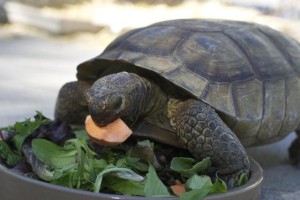Desert Tortoise
 Desert Tortoise
Desert Tortoise
Gopherus agassizii
Desert tortoises are native to the deserts of Southern California, Arizona, Nevada, and northern Mexico. They are a threatened species in California and are considered an “indicator” species for the health of desert ecosystems. Their numbers have declined due to urban expansion, road development, off-road vehicles, mining, overgrazing, road kills, capture as pets, and the spread of disease.
Desert tortoises eat grasses, wildflowers, cactus and herbs. Like all desert species, they are designed to live with very little water and can survive a year or more without drinking. To escape the heat of the summer and the cold of winter, they dig burrows with their strong flat front claws. In winter, they hibernate in their burrows.
They are the state reptile of California and Nevada.
Desert tortoises can live a long time—up to 100 years! Our desert tortoise, Dandelion, was taken from the wild in 1962 to be a pet and has been at the museum since 1997. Captive tortoises cannot be released back into the wild because they may carry disease that could harm the wild population.
It is illegal and prohibited to take desert tortoises out of the wild and keep them as pets. When you visit, you may notice that Dandelion has a sticker on her shell which is proof of our special permit to keep and care for her.
Conservation tip: You can help tortoises and other desert species by protecting desert habitats and not disturbing or picking up wild animals when you visit and staying on designated walking paths.
Dandelion is a favorite of volunteers, staff and visitors alike. She gets her name from her very favorite food, dandelion flowers! From about October to March she goes into what is called “brumation”, a period of inactivity where she will preserve her energy until the weather warms up. She previously brumated off site at a volunteer’s house but now she brumates in our very own exhibit hall!
